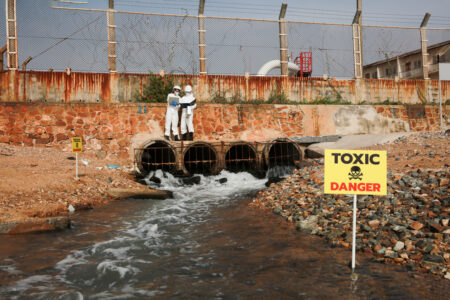
Share On Social!
The Environmental Protection Agency (EPA) is taking another step forward in its campaign against “forever chemicals,” also known as perfluorinated and polyfluorinated alkyl substances (PFAS).
On April 10, 2024, the EPA announced its final ruling on the first-ever PFAS drinking water standard in the country.
The EPA ruled in favor of the legally enforceable standard that limits PFAS, which has been linked to adverse health effects such as impacts to fetal growth and increased cancer risk, in drinking water.
The final ruling on the matter comes nearly a year after closing public comment on the issue, which garnered 121,969 comments — 832 of them from Salud America! members who submitted a model comment in support of the regulation.
PFAS Drinking Water Standard
As per the new standard, public water systems will be required to monitor and reduce PFAS levels, according to a White House news release.
If PFAS exceeds a certain level, these water systems will have to notify the public.
The rule is applicable to five types of PFAS, including two of the most common PFAS —PFOA and PFOS, which can be found in packaging, carpeting, and more.
In addition, the EPA is limiting combinations of four types of PFAS, including chemicals known as GenX chemicals, which can be found in cleaning products and non-stick coatings.
“This standard will reduce PFAS exposure in our drinking water to the lowest levels that are feasible for effective nationwide implementation,” according to the news release.
To help meet the new standard, the presidential administration is giving states funding for PFAS detection and treatment systems while investing in other safe drinking water measures throughout the country.
Why is the Drinking Water Standard Needed?
The EPA says that the new standard will protect 100 million Americans from PFAS and prevent tens of thousands of illnesses and deaths associated with PFAS exposure.
PFAS have existed since the 1940s and can be found in many common products such as firefighting foam, adhesives, and food packaging.
These types of chemicals are notoriously impervious to environmental degradation, making them more difficult to dispose of and break down over time.
It also makes it easier for these chemicals to find their way into water supplies in communities located near chemical waste plants.
Oakdale, located outside of St. Paul, Minnesota, is one such community afflicted by PFAS in drinking water.
This area has experienced higher rates of cancer death in children compared to neighboring areas, according to the news release.
With the release of these chemicals into the environment and drinking water, even breast milk has been tested positive for PFAS.
How the New Standard Helps Latino Communities
The new standard aims to protect communities from chemical exposure.
Contamination and pollution have been shown to disproportionately affect low-income communities and communities color, such as Latinos.

That’s because many of these populations are more likely to live in areas where hazardous waste facilities and other industries that could potentially pollute the environment around them are located, according to PolicyLink.
What’s more, many Latinos live in areas known as food deserts or food swamps, where healthy food can be difficult to come by. That means many Latinos rely on conveniences such as fast-food, which comes in PFAS-containing packaging, to feed their families.
This increases their exposure to PFAS and the many chronic health conditions linked to PFAS, while making them more prone to modifiable risk factors like obesity and diabetes.
Despite these inequities, PFAS has found a way to pollute the environment and drinking water in all 50 states and Perto Rico, which has a large Latino population — affecting us all, according to the White House news release.
“All communities deserve to have safe, clean water. Yet the ‘forever chemicals’ known as PFAS threaten the health and wellbeing of one-third of Americans,” said Michael McAfee, President and CEO of PolicyLink.
“We cannot place the cost of this contamination and impacts to public health on vulnerable communities. For our water systems and infrastructure to be equitable, we need the federal government to set clear standards in the interest of public and environmental health, to support our critical water utilities in their efforts to clean and transport water, and to hold polluters accountable.”
Federal PFAS Intervention
The final ruling is the first-ever Safe Drinking Water Act standard for PFAS and is the first time any new contaminants have been added since 1996, according to the White House.
While it may be the first, it most likely won’t be the last.
This latest victory for environmental and health justice is just one of many battles being waged against PFAS by the US government.
There are continuous efforts to protect firefighters from the harmful effects of PFAS, which is found in firefighting foam, by providing PFAS blood tests and promoting access to early cancer screenings. The Department of Defense is identifying firefighting foams that don’t have PFAS in them to replace the ones that do.
In addition, federal agencies are supporting healthcare providers by providing PFAS health information, and the Food and Drug Administration is attempting to phase out the use of PFAS packaging to reduce exposure.
Government agencies are also finding ways to cut back on using items with PFAS, such as not using cleaning products with PFAS as an ingredient, according to the news release.
Currently, the EPA is weighing a decision to place several PFAS on its list of hazardous chemicals, which will hold facilities that treat, store, and dispose of hazardous wastes accountable for pollution.
Identify Possible Areas of PFAS Exposure in Your Community
From what we eat and drink to what we wear and cook in, exposure to chemicals like PFAS and other toxins is all around us.
To stay on top of the potential dangers of toxic exposure can have on your family and the rest of your community, download a Salud America! Health Equity Report Card!
The Health Equity Report Card can tell you where your community falls in the way of air and water pollution, areas that have higher prevalence of disease, which could point to higher PFAS exposure, and which neighborhoods have lower access to healthy food options.
You can use the data laid out in graphs and maps to compare your community with the rest of the state and country to make a case for environmental change with local policymakers or share it on social media to raise awareness about health inequities where you live!
GET YOUR HEALTH EQUITY REPORT CARD!
By The Numbers
1
Quick Survey
Can help you find out how chemically sensitive you are



